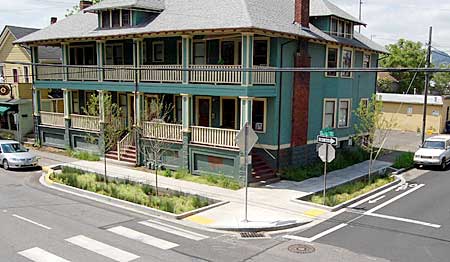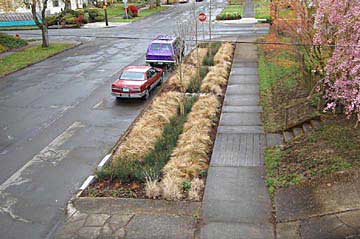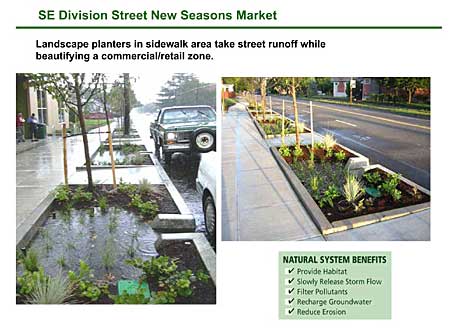
 |
|
|
|
Green Streets improve water quality and beautify cities by Celia Scott and Debbie Bulger  Corner curb extensions in Portland, Oregon beautify the street, divert stormwater from the ocean, and provide a safer crossing for pedestrians. Photo by Dave Elkin, ©SustainableStormwater.com How a coastal city deals with stormwater runoff has a major effect on the health of the bay or ocean the city faces. City runoff is laden with gasoline, oil, tire dust and other pollutants from our streets. Because water runs downhill, urban runoff which is not properly managed will pollute all the water bodies that receive it. On the Central Coast, that runoff ends up in our creeks, our rivers, and the Monterey Bay National Marine Sanctuary. Portland, Oregon, and Seattle, Washington, are demonstrating to the world there is a better way. These cities, and others across the United States, are designing and building Green Streets which trap stormwater runoff and capture pollutants. Green Streets use landscape-based drainage features such as green planters, curb extensions, swales, and porous paving to mimic the natural hydrologic cycle, control flow, and improve water quality while at the same time beautifying and increasing the safety of streets. Experience in multiple cities across the U.S. has shown that Green Streets can be more cost efficient in managing urban stormwater runoff than the usual “gray” infrastructure of concrete gutters and storm drains. Cities which have constructed Green Street structures include Milwaukee, Philadelphia, and Chicago, in addition to Portland, Seattle, and others. In April 2007, the Portland City Council approved a Green Street policy in order to  Green Streets trap stormwater runoff and capture pollutants. Photo from portlandonline.com • Reduce polluted stormwater entering Portland’s rivers and streams, • Improve pedestrian and bicycle safety, • Divert stormwater from the sewer system and reduce basement flooding and sewer backups, • Reduce impervious surface so stormwater can recharge groundwater, • Increase urban green space, • Improve air quality and reduce air temperatures, • Address federal and state requirements to protect watersheds, and • Increase opportunities for industry professionals. The Portland City website is a fountain of information about Green Streets including a copy of their policy, photos of projects throughout the city, detailed construction drawings, and evaluation criteria, to mention a few of the resources. These can be accessed at www.portlandonline.com. To fund Green Streets, Portland adopted a “One Percent for Green Fund.” Projects that trigger the requirements of the City’s Stormwater Management Manual must construct Green Streets. If a project does not fall under those re- quirements, the city collects one percent of the construction budget to support construction of Green Street facilities. The monies collected are then available for other projects in the city. The funds are collected by the Bureau of Environmental Services. How’s that for a city department! Those interested in protecting our precious watersheds and the ocean can profit from studying the examples of other communities that have moved ahead in best practices for stormwater management. In addition to the Portland City website, check out the Center for Neighborhood Technology Green Values Tool Kit at http://greenvalues.cnt.org.  Sidewalk planting areas in Portland, Oregon collect rainwater and street runoff and return them to the water table. Photo from portlandonline.com We need to make sure that every city and country public works department on the central coast is familiar with Green Streets and is working to incorporate those principles into our community projects. |
|